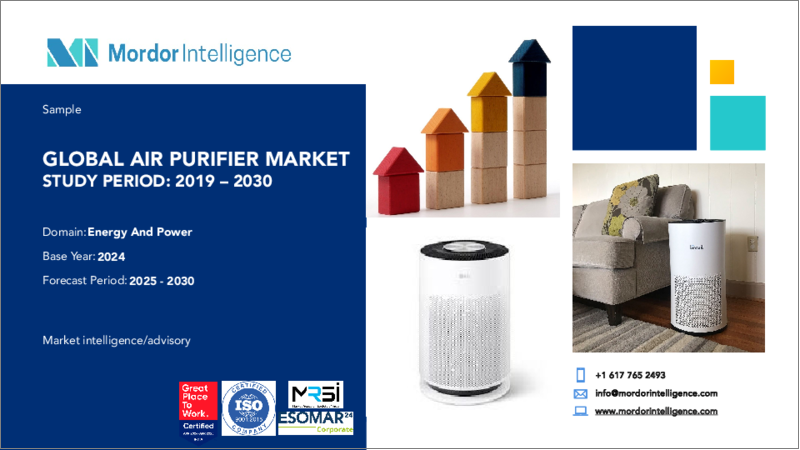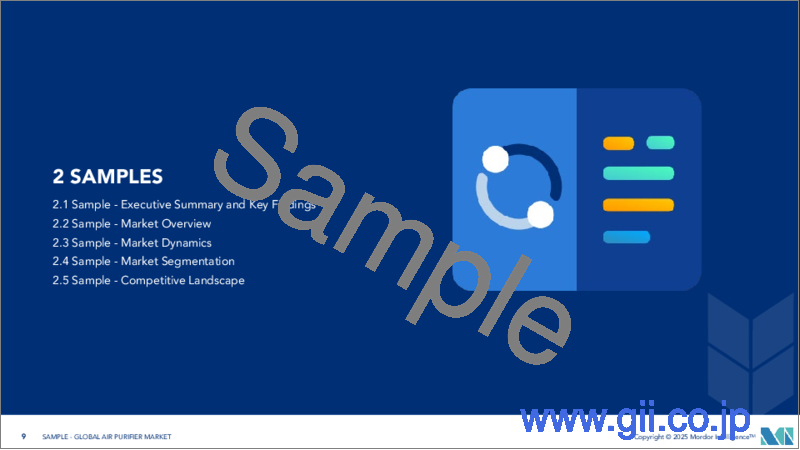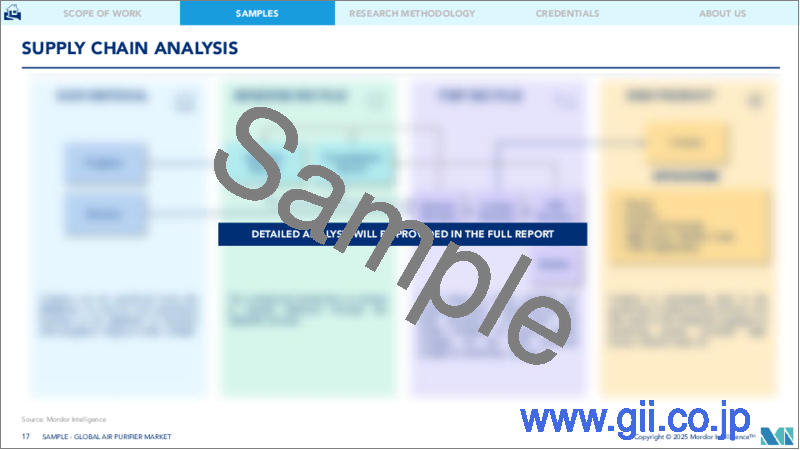|
|
市場調査レポート
商品コード
1641877
空気清浄機:市場シェア分析、産業動向・統計、成長予測(2025~2030年)Air Purifier - Market Share Analysis, Industry Trends & Statistics, Growth Forecasts (2025 - 2030) |
||||||
カスタマイズ可能
適宜更新あり
|
|||||||
価格
| 空気清浄機:市場シェア分析、産業動向・統計、成長予測(2025~2030年) |
|
出版日: 2025年01月05日
発行: Mordor Intelligence
ページ情報: 英文 125 Pages
納期: 2~3営業日
|
全表示
- 概要
- 目次
概要
空気清浄機市場規模は2025年に180億1,000万米ドルと推定され、予測期間(2025~2030年)のCAGRは7%で、2030年には252億6,000万米ドルに達すると予測されます。

主要ハイライト
- 空気感染性疾患の増加、産業活動による排出量の増加、消費者の健康意識の高まりなどの要因が市場を牽引しています。
- 一方、さまざまな技術開発が進んでいるにもかかわらず、空気清浄機は、設置コストやメンテナンスコストが高いため、特に商業と住宅セグメントにおいて、低開発経済諸国と新興経済諸国の両方で贅沢品として認識されています。このことが逆に市場の成長を妨げると予想されます。
- 人口密度の高いアジア太平洋では大気汚染が深刻な課題となっており、環境、公衆衛生、農作物の収量が損なわれています。しかし、このような問題は空気清浄機市場にとって将来的にいくつかの機会を生み出す可能性が高いです。
- 予測期間中、アジア太平洋が市場を独占し、需要の大半はバングラデシュ、インド、ベトナムなどの国々からもたらされると予想されます。
空気清浄機市場の動向
高効率粒子状空気(HEPA)セグメントが市場を独占する見込み
- HEPAフィルターなどの機械式エアフィルターは、粒子をフィルター材料に捕獲して除去します。ホコリ、花粉、カビの胞子、動物のフケ、ダニやゴキブリのアレルゲンを含む粒子など、空気中に浮遊する大きな粒子を捕捉します。
- HEPAフィルターは拡大表面フィルターの一種で、表面積が大きく、浮遊粒子の大小を問わず除去効率が高いです。さらに、このエアフィルターはプリーツフィルターよりも呼吸可能な粒子を効率的に除去します。HEPA空気清浄機に要求される2つの最も一般的な規格には、0.3マイクロメートル以上の粒子を除去する能力、すなわち99.95%(欧州規格)または99.97%(ASME規格)が含まれます。
- 過去10年間、HEPAフィルターは、様々な医療施設やライフサイエンス用途において、空気中の粒子やウイルスやバクテリアなどの生物の拡散を抑制することが証明されてきました。多くの専門技術者団体は、微生物やその他の危険な粒子を除去するために、病院、感染制御クリニック、その他の医療施設でのHEPAフィルターを推奨しています。
- さらに近年、世界中の汚染レベルが劇的に上昇しています。そのため、この産業で事業を展開する企業は、革新的な製品の開発と導入に注力しています。
- 例えば、2023年10月、空気清浄機製造会社ISO-Aireは、RSF500と呼ばれる新しいHEPA清浄機のバリエーションを発売しました。このモデルは毎分500立方フィートを供給し、小規模から中規模のオフィスに適しています。また、有害な汚染物質や空気中に浮遊する細菌を除去するため、3段階の空気濾過保護を記載しています。このようなHEPA空気清浄機のバリエーションは、将来的に普及する可能性が高いです。
- World Air Quality Reportによると、2023年に粒子状物質(PM)2.5の濃度が最も高いのはバングラデシュで79.9マイクログラム/立方メートル(μg/m3)、次いでパキスタンが73.7μg/m3、54.4μg/m3、タジキスタンが49μg/m3、ブルキナファソが46.6μg/m3となっています。
- したがって、こうした要因から、予測期間中は高効率微粒子空気(HEPA)技術が市場を独占すると予想されます。
アジア太平洋が市場を独占する見込み
- アジア太平洋は、空気清浄機市場における需要の起爆剤となっています。インド、バングラデシュ、タジキスタン、インドネシア、ベトナム、中国などの開発途上国では、工業化活動の活発化と人口増加により、産業成長がピークに達しています。これが予測期間中の需要を牽引すると予想されます。
- World Air Quality Reportによると、PM2.5の平均濃度が最も高かったのはインドで92.7μg/m3、バングラデシュが80.2μg/m3、タジキスタンが46μg/m3、中国が34.1μg/m3、インドネシアが43.8μg/m3でした。
- 一方、インドでは、空気清浄機の市場は主に大都市に限られています。しかし、予測期間中は成長が見込まれています。2023年11月、ニルヴァーナはインド初の微小電気集塵装置(MESP)技術ベースの空気殺菌清浄機を発売しました。MESP技術はインドの大気条件で最高の性能を発揮し、PM2.5、ほこり、煙、ウイルス、細菌、花粉を防ぐと考えられています。
- ベトナムの空気清浄機市場は急拡大しており、その主要理由は、消費者が微細粉塵を気にするようになったことによる需要の急増です。2024年2月、空気清浄機メーカーであるレボワは、住宅用と業務用のレボワ・コア200Sという新製品を発売しました。レボワット・コア200Sは、エッセンシャルナイロンコア、H13トゥルーHEPAコア、インナー活性炭コアの3層フィルターを搭載しています。0.3ミクロンの浮遊粒子を99.97%除去します。このような製品は、ベトナムの有害な排気レベルから人々を守る可能性が高いです。
- 従って、このような要因によって、予測期間中、アジア太平洋が空気清浄機市場を独占することになると予想されます。
空気清浄機産業概要
空気清浄機市場はセグメント化されています。この市場の主要企業(順不同)には、Daikin Industries, Ltd.、Sharp Corporation、IQAir、LG Electronics Inc.、Dyson Ltd.などがあります。
その他の特典
- エクセル形式の市場予測(ME)シート
- 3ヶ月間のアナリストサポート
目次
第1章 イントロダクション
- 調査範囲
- 市場の定義
- 調査の前提
第2章 エグゼクティブサマリー
第3章 調査手法
第4章 市場概要
- イントロダクション
- 2029年までの市場規模と需要予測(単位:10億米ドル)
- 最近の動向と開発
- 政府の規制と施策
- 市場力学
- 促進要因
- 抑制要因
- サプライチェーン分析
- ポーターのファイブフォース分析
- 供給企業の交渉力
- 消費者の交渉力
- 新規参入業者の脅威
- 代替品の脅威
- 競争企業間の敵対関係の強さ
第5章 市場セグメンテーション
- 濾過技術
- 高効率粒子状空気(HEPA)
- その他の濾過技術(電気集塵装置(ESP)、イオナイザー、オゾン発生装置など)
- タイプ
- 独立型
- インダクト
- エンドユーザー
- 住宅用
- 商業用
- 産業用
- 地域
- 北米
- 米国
- カナダ
- その他の北米地域
- 欧州
- 英国
- ドイツ
- スペイン
- ノルディック
- ロシア
- トルコ
- イタリア
- その他の欧州
- アジア太平洋
- 中国
- インド
- 日本
- マレーシア
- タイ
- インドネシア
- ベトナム
- その他のアジア太平洋
- 南米
- ブラジル
- アルゼンチン
- コロンビア
- その他の南米
- 中東・アフリカ
- アラブ首長国連邦
- サウジアラビア
- 南アフリカ
- ナイジェリア
- カタール
- エジプト
- その他の中東・アフリカ
- 北米
第6章 競合情勢
- M&A、合弁事業、提携、協定
- 主要企業の戦略
- 企業プロファイル
- Daikin Industries Ltd
- Sharp Corporation
- Resideo Technologies Inc.
- LG Electronics Inc.
- Unilever PLC
- Dyson Ltd
- Whirlpool Corporation
- AllerAir Industries Inc.
- Panasonic Corporation
- Koninklijke Philips NV
- IQAir
- Samsung Electronics Co. Ltd
- Winix Inc.
- Xiaomi Corp.
- 市場ランキング分析
第7章 市場の可能性と今後の動向
目次
Product Code: 61329
The Air Purifier Market size is estimated at USD 18.01 billion in 2025, and is expected to reach USD 25.26 billion by 2030, at a CAGR of 7% during the forecast period (2025-2030).

Key Highlights
- Factors such as increasing airborne diseases, rising emissions due to industrial activities, and growing consumer health consciousness are driving the market.
- On the other hand, despite the various technological developments, air purifiers have been perceived as a luxury item in both underdeveloped and emerging economies, particularly in the commercial and residential segments, owing to the high installation and maintenance costs. This, in turn, is expected to hinder the market's growth.
- Growing air pollution in the densely populated Asia-Pacific region has emerged as a significant challenge, damaging the environment, public health, and agricultural crop yields. However, such problems will likely create several future opportunities for the air purifier market.
- Asia-Pacific is expected to dominate the market during the forecast period, with most of the demand coming from countries like Bangladesh, India, and Vietnam.
Air Purifier Market Trends
The High-efficiency Particulate Air (HEPA) Segment is Expected to Dominate the Market
- Mechanical air filters, such as HEPA filters, remove particles by capturing them on filter materials. They capture large airborne particles, such as dust, pollen, mold spores, animal dander, and particles containing dust mite and cockroach allergens.
- HEPA filters are a type of extended-surface filter with a larger surface area and higher efficiencies for removing larger and smaller airborne particles. Moreover, these air filters remove respirable particles more efficiently than pleated filters. The two most common standards required for HEPA air purifiers include the capability to remove particles, i.e., 99.95% (European Standard) or 99.97% (ASME Standard), which have a size greater than or equal to 0.3 micrometers.
- For the last decade, HEPA filters have been proven to control the spread of airborne particles and organisms, such as viruses and bacteria, across various healthcare facilities and life sciences applications. Many professional engineering organizations recommend HEPA filters in hospitals, infection control clinics, and other healthcare facilities to eliminate microbes and other dangerous particles.
- Further, pollution levels around the globe have increased dramatically in recent years. Hence, companies operating in the industry have focused on developing and introducing innovative products.
- For instance, in October 2023, the air purifier manufacturing company ISO-Aire launched its new HEPA purifier variant called RSF500. The model delivers 500 cubic feet per minute and is feasible for small to medium-sized offices. It also offers three levels of air filtration protection to eliminate harmful pollutants and airborne germs. Such HEPA air purifier variants are likely to get traction in the future.
- As per the World Air Quality Report, the highest concentration of particulate matter (PM) 2.5 in 2023 was noted in Bangladesh at 79.9 micrograms per cubic meter (µg/m3), followed by Pakistan at 73.7 µg/m3, 54.4 at µg/m3, Tajikistan at 49 µg/m3 and Burkina Faso at 46.6 µg/m3.
- Therefore, owing to such factors, high-efficiency particulate air (HEPA) technology is expected to dominate the market during the forecast period.
Asia-Pacific is Expected to Dominate the Market
- Asia-Pacific has been a catalyst for demand in the air purifier market. In developing nations such as India, Bangladesh, Tajikistan, Indonesia, Vietnam, and China, industrial growth is at its peak owing to increased industrialization activities and population growth. This is expected to drive demand during the forecast period.
- As per the World Air Quality Report, the highest average PM 2.5 concentration in India stood at 92.7 µg/m3, Bangladesh at 80.2 µg/m3, Tajikistan at 46 at µg/m3, China at 34.1 µg/m3, and Indonesia at 43.8 µg/m3.
- On the other hand, in India, the market for air purifiers is mainly confined to metropolises. However, it is expected to grow during the forecast period. In November 2023, Nirvana rolled out India's first-ever Micro-electrostatic precipitator (MESP) technology-based air sterilizing purifier. The MESP technology is deemed to perform best in Indian atmospheric conditions and protect against PM 2.5, dust, smoke, viruses, bacteria, and pollen.
- The air purifier market in Vietnam is expanding rapidly, mainly due to surging demand as consumers become more concerned about fine dust. In February 2024, the air purifier company Levoit launched a new one called Levoit Core 200S for residential and commercial use. Levoit Core 200S has a 3-layer filter with an essential Nylon core, an H13 True HEPA core, and an inner activated carbon core. It filters up to 99.97% of airborne particles with a size of 0.3 microns. Such products are likely to protect people from harmful emission levels in Vietnam.
- Therefore, such factors are expected to make Asia-Pacific the dominant air purifier market during the forecast period.
Air Purifier Industry Overview
The air purifier market is fragmented. Some key players in this market (not in a particular order) include Daikin Industries Ltd, Sharp Corporation, IQAir, LG Electronics Inc., and Dyson Ltd.
Additional Benefits:
- The market estimate (ME) sheet in Excel format
- 3 months of analyst support
TABLE OF CONTENTS
1 INTRODUCTION
- 1.1 Scope of the Study
- 1.2 Market Definition
- 1.3 Study Assumptions
2 EXECUTIVE SUMMARY
3 RESEARCH METHODOLOGY
4 MARKET OVERVIEW
- 4.1 Introduction
- 4.2 Market Size and Demand Forecast in USD billion, till 2029
- 4.3 Recent Trends and Developments
- 4.4 Government Policies and Regulations
- 4.5 Market Dynamics
- 4.5.1 Drivers
- 4.5.2 Restraints
- 4.6 Supply Chain Analysis
- 4.7 Porter's Five Forces Analysis
- 4.7.1 Bargaining Power of Suppliers
- 4.7.2 Bargaining Power of Consumers
- 4.7.3 Threat of New Entrants
- 4.7.4 Threat of Substitute Products and Services
- 4.7.5 Intensity of Competitive Rivalry
5 MARKET SEGMENTATION
- 5.1 Filtration Technology
- 5.1.1 High-efficiency Particulate Air (HEPA)
- 5.1.2 Other Filtration Technologies (Electrostatic Precipitators (ESPs), Ionizers and Ozone Generators, etc.)
- 5.2 Type
- 5.2.1 Stand-alone
- 5.2.2 In-duct
- 5.3 End User
- 5.3.1 Residential
- 5.3.2 Commercial
- 5.3.3 Industrial
- 5.4 Geography
- 5.4.1 North America
- 5.4.1.1 United States
- 5.4.1.2 Canada
- 5.4.1.3 Rest of North America
- 5.4.2 Europe
- 5.4.2.1 United Kingdom
- 5.4.2.2 Germany
- 5.4.2.3 Spain
- 5.4.2.4 NORDIC
- 5.4.2.5 Russia
- 5.4.2.6 Turkey
- 5.4.2.7 Italy
- 5.4.2.8 Rest of Europe
- 5.4.3 Asia-Pacific
- 5.4.3.1 China
- 5.4.3.2 India
- 5.4.3.3 Japan
- 5.4.3.4 Malaysia
- 5.4.3.5 Thailand
- 5.4.3.6 Indonesia
- 5.4.3.7 Vietnam
- 5.4.3.8 Rest of Asia-Pacific
- 5.4.4 South America
- 5.4.4.1 Brazil
- 5.4.4.2 Argentina
- 5.4.4.3 Colombia
- 5.4.4.4 Rest of South America
- 5.4.5 Middle East and Africa
- 5.4.5.1 United Arab Emirates
- 5.4.5.2 Saudi Arabia
- 5.4.5.3 South Africa
- 5.4.5.4 Nigeria
- 5.4.5.5 Qatar
- 5.4.5.6 Egypt
- 5.4.5.7 Rest of Middle East and Africa
- 5.4.1 North America
6 COMPETITIVE LANDSCAPE
- 6.1 Mergers and Acquisitions, Joint Ventures, Collaborations, and Agreements
- 6.2 Strategies Adopted by Leading Players
- 6.3 Company Profiles
- 6.3.1 Daikin Industries Ltd
- 6.3.2 Sharp Corporation
- 6.3.3 Resideo Technologies Inc.
- 6.3.4 LG Electronics Inc.
- 6.3.5 Unilever PLC
- 6.3.6 Dyson Ltd
- 6.3.7 Whirlpool Corporation
- 6.3.8 AllerAir Industries Inc.
- 6.3.9 Panasonic Corporation
- 6.3.10 Koninklijke Philips NV
- 6.3.11 IQAir
- 6.3.12 Samsung Electronics Co. Ltd
- 6.3.13 Winix Inc.
- 6.3.14 Xiaomi Corp.
- 6.4 Market Ranking Analysis






